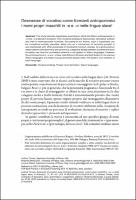Chapter Desinenze di vocativo come formanti antroponimici. I nomi propri maschili in -e e -o nelle lingue slave
| dc.contributor.author | Trovesi, Andrea | |
| dc.date.accessioned | 2024-04-02T15:51:08Z | |
| dc.date.available | 2024-04-02T15:51:08Z | |
| dc.date.issued | 2023 | |
| dc.identifier | ONIX_20240402_9791221502169_228 | |
| dc.identifier.issn | 2612-7679 | |
| dc.identifier.uri | https://library.oapen.org/handle/20.500.12657/89259 | |
| dc.language | Italian | |
| dc.relation.ispartofseries | Biblioteca di Studi Slavistici | |
| dc.subject.classification | thema EDItEUR::C Language and Linguistics::CF Linguistics | |
| dc.subject.classification | thema EDItEUR::D Biography, Literature and Literary studies::DS Literature: history and criticism | |
| dc.subject.other | Vocative endings | |
| dc.subject.other | Proper noun formation | |
| dc.subject.other | Slavic languages | |
| dc.title | Chapter Desinenze di vocativo come formanti antroponimici. I nomi propri maschili in -e e -o nelle lingue slave | |
| dc.type | chapter | |
| oapen.abstract.otherlanguage | The study tests the hypothesis according to which the Slavic anthroponyms in -e and -o underwent evolution from vocative endings to hypocoristic derivative suffixes and then to anthroponymic formants. According to the Author, such a hypothesis can be considered entirely plausible, albeit only as a mechanism of formation parallel to and intertwined with other processes of morphemic function change. As a phenomenon observable in both diachrony and synchrony, categorial lability between vocative and word formation can thus be considered inherent in the system of Slavic languages. However the anthroponyms in -e and -o have had different diffusion and distribution in the various Slavic languages and today occupy dissimilar places within the system and varieties of each language. | |
| oapen.identifier.doi | 10.36253/979-12-215-0216-9.07 | |
| oapen.relation.isPublishedBy | bf65d21a-78e5-4ba2-983a-dbfa90962870 | |
| oapen.relation.isbn | 9791221502169 | |
| oapen.series.number | 54 | |
| oapen.pages | 8 | |
| oapen.place.publication | Florence |

